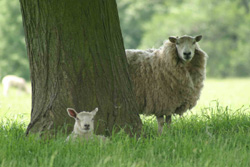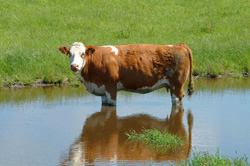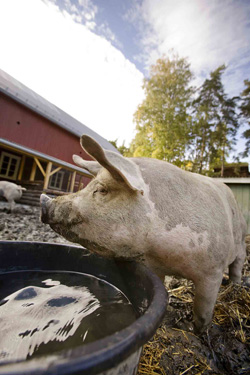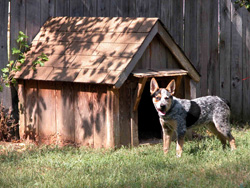Caring for animals during extreme heat
Managing animals in high temperatures requires good forward planning. Keeping an eye on the weather forecasts and developing a plan for days of high to extreme temperatures (over 360C if dry heat, less if humid) is essential in ensuring that your animals will have sufficient shade and water on those very hot days.
Extreme heat causes significant stress for all animals. There are a few simple guidelines you can follow to reduce the impacts of high temperatures on animals.
It is the responsibility of owners or people in charge of animals to be well prepared for heat events to ensure the welfare of their animals is maintained. This includes forward planning of farm infrastructure to provide shaded areas with good ventilation to maximise heat loss. Animals need to be checked regularly throughout the day for signs of heat stress, along with water points to ensure animals have access to ample cool water.
Plentiful water supply for your animals
The provision of plentiful clean, cool water and shade is essential.
Water troughs or containers should be large enough and designed in such a way that all animals have easy access. The number of watering points and water flow should be increased if a large number of animals are kept together.
Troughs or containers should be firmly fixed so they cannot overturn. They should be kept clean and should be designed and maintained to prevent injuries. Large concrete troughs help keep drinking water cool.
Water pipes should be of sufficient diameter with sufficient pressure to cope with periods of peak demand. and buried around 15cm deep to keep the water cool. Unless you are around to continually check water containers, water should be provided through automatic or reticulated systems as containers may be emptied or tipped over by thirsty animals.
The location of water should be familiar to animals in the days before extreme heat occurs. Animals should not have to walk too far for water. If putting livestock into a new paddock, especially where pasture is high, ensure they are familiarised with watering points as the height of pasture may prevent them from seeing the water sites (especially young or small stock).
Types of shelter to protect from heat
Animals need to be provided with shelter during extended periods of extreme temperatures. Shelter is especially important for very young or old animals and animals that are in poor condition or sick.
The best type of shelter during extreme heat protects the animals from the sun and allows for the cooling effect of wind. The following is a list of shelter alternatives:
- Constructed shelters – using materials such as shade cloth, corrugated iron or timber. Aluminium or galvanised steel are ideal roofs for shelters, kennels, and chicken coops as these materials are very good at reflecting the radiative rays of the sun.
- Trees with large canopies can be planted individually in fields. Trees have a cooling effect due to absorption of heat by the leaves.
- Naturally undulating paddocks and gullies.
- Shelterbelts – thick hedges of trees often fenced off from stock, shelter belts can provide good protection from sun, but should be thinned evenly to allow wind flow and planted in an east-west direction to provide shade during the hottest part of the day.
- Forestry blocks can provide temporary shelter from extreme heat.
- Pets and small animals should be moved to cool areas of the house or shed.
During extreme heat conditions wind flow is important for keeping animals cool, so this should be considered when deciding type and location of shelter.
Holding and processing areas for livestock should have shaded areas available. Use of water sprinklers or misters can be useful to cool some species such as pigs and cattle.
Risk of smothering
If insufficient shelter is provided for large groups of livestock there is the risk of animals crowding together under shelter resulting in smothering. It is important that shelter is available to all animals at the same time. It is preferable that shelter includes sufficient room for all animals to be able to lie down, as this assists with cooling.
It may be necessary to divide the number of animals into smaller groups. Group mentality may mean that even when animals have access to several smaller areas of shelter they will tend to camp together crowding under one source and around water.
Outdoor poultry houses
Outdoor poultry houses (for example free range set ups or backyards) should be positioned in an area that is shaded from the sun and has good airflow. Insulate the east and west walls if necessary. Use wide overhangs at the eaves and solid end walls. In addition, an angled roof will reflect more heat at the hottest time of the day if the face of the slope is not directly facing the sun. The construction and positioning of nest boxes should be such that they avoid becoming heat traps.
Handling animals on hot days
It is recommended not to handle animals in extreme heat unless absolutely necessary. If necessary, make sure it is done as early or late in the day as possible when temperatures are lower.
Research has shown that movement or handling of cattle during hot weather can increase their body temperature by 0.5 to 3.5° C. Increased body temperature or heat stress will cause production losses in livestock and impact on their ability to maintain normal function.
Moving animals during cooler hours can decrease the impact of high temperatures on production performance. For example, a delay in milking by an hour or more in the evenings can result in an increase in production of up to 1.5 litres/day/cow.
Transporting animals during the heat
Transport of animals should be planned so that climatic extremes likely to compromise the animals' welfare are avoided.
If transport is absolutely necessary, the journey plan should minimise the effects of hot weather on the animals:
- pre-determine your route
- mark out a map with places of shade and water availability (such as rest stops)
Animals should only be transported during the cooler hours of the day.
If it is necessary to stop, park the vehicle in the shade and at right angles to the wind direction to improve wind flow between animals during hot weather. Duration of stops should be kept to a minimum to avoid the build-up of heat while the vehicle is stationary.
Stocking densities should be reduced to 85% of capacity to ensure good air flow between animals, and drivers should have contingency plans in place for the occurrence of adverse weather events.
Heat stress tolerance for livestock
Animals at high risk of heat stress include:
- young animals
- dark coloured animals
- animals that have been sick or have a previous history of respiratory disease
Heat stress tolerances can also vary between and within a species, for example:
- pigs become heat stressed at a lower temperature level and are very prone to sunburn
- sheep that are newly shorn are at risk of heat stress and sunburn due to lack of insulation from heat provided by wool
- high producing dairy cows are more affected by extreme heat than lower producing cows
- lactating cattle are more susceptible than dry cows because of the additional metabolic heat generated during lactation
- beef cattle with black hair suffer more from direct solar radiation than those with lighter hair, although those with pink skin are at risk of sunburn
- Holsteins are less tolerant than Jersey cows
- British breeds of sheep and cattle are less tolerant than merino or tropical beef breeds
- heavy cattle over 450kg are more susceptible than lighter ones
- cattle, alpacas and llamas are more prone to heat stress than sheep and goats
These types of animals should be watched more closely for signs of heat stress during days of high temperature.
Identifying heat stress
There are many signs of heat stress that you can look for in your animals. Some general signs include:
- panting
- increased respiration rate
- increased water intake
- loss of appetite
- listless or lethargy
- increased salivation
- in severe cases may become unconscious
You should ensure you are well informed on the heat stress signs of any species you own and watch closely during days of extreme heat. See the specific species information below for further details.
Treating heat stress
If your animals are showing signs of heat stress the following actions can be taken to cool them down:
- Move them to the shade immediately, preferably somewhere with a breeze. If animals are too stressed to move, pick them up and move them or provide shade where they are.
- Offer plenty of cool clean water but encourage them to drink small amounts often. Spray them with cool water, especially on the legs and feet, or stand them in water. Use sprinklers or hoses for cattle, pigs and horses. Lay wet towels over them. Dogs and cats can be placed in buckets/troughs of cool water. Poultry should not be wet down unless there is a breeze to aid the cooling process.
- Increase air movement around them. This can be done with fans, ventilation, or wind movement.
- Decrease stocking rates to allow animals room to lie down.
- If the animal shows no sign of improvement contact your local vet for assistance.
While heat stress can have significant impacts on production and animal welfare, by making some minor management changes and taking a little extra care of your animals during periods of extreme hot weather, the effects of heat stress can be substantially reduced.
Heat stress for specific types of animals
The following information provides more detail on dealing with heat stress for specific species or types of animals.
 Livestock
Livestock
Providing shade or shelter for livestock helps them to deal better with the heat and can reduce production losses that may result from heat stress. Heat stress can have a significant effect on production and reproduction so it is important that shelter and a plentiful supply of cool water are available.
In times of excessive heat livestock may crowd around water sources and place greater demand on water supplies. Ensure they are adequate to cope with an increased demand.
During cool months make it routine farm maintenance to check all troughs and water lines to ensure they will not break down in the hotter months. For example, service pumps and replace seals if necessary. Check floats on troughs.
Water lines should be buried at least 15cm (6 inches) deep to prevent them heating up the water prior to entering the water point
While shelter and water should ideally be close together, care should be taken with livestock that this does not result in animals camping around the water source, causing overcrowding and preventing all animals from accessing water. Ensure enough shelter and trough access for all stock. Placement of troughs should also be carefully considered to prevent animals crowding between fences and the trough.
Feed digestion causes heat production which will contribute to the animals heat load. Provide animals with high quality feed to maintain nutrient intake without excessive heat production, and feed out in early morning or evening when temperatures are lower.
Horses
Horses that are heat stressed may also show signs of excessive sweating and reduced feed intake.
Restrict exercising your horse to the early morning and late afternoon/evening when it is coolest. Electrolytes can be added to their feed to replace essential salts lost through sweating.
Heat stressed horses can be cooled down by hosing with cool water, starting from the feet and moving up slowly, sponging with water or by placing wet towels over them.
Excess water must be scraped off afterwards unless there is a good breeze, as water in the coat on a hot, humid, still day will act as an insulator and it will quickly warm up again.
 Dairy cattle
Dairy cattle
Cattle that are heat stressed will show increased respiration rates as they try to cool themselves down. If cows are taking more than 60 breaths per minute you need to take action.
Provide plenty of shade as this can reduce the amount of solar radiation received by the cow by up to 50%.
Alter your paddock rotation so that cattle are in paddocks that are close to the dairy to reduce the distance cattle have to walk in extreme heat.
Use sprinklers and shade in holding yards. To be effective the sprinklers must wet the cows to the skin. Air flow is also important. Sprinklers have been found to improve milk production, reduce fly irritation and make for more contented cows in the shed with better milk let down.
Let cattle take their time and allow them to drink water on the way to and from the dairy. Cows can also cool themselves by standing in cold water which allows them to disperse some of their heat load so access to a dam or other source of cool water can be useful in reducing heat stress.
Further information on cattle and heat can be found at the Cool Cows website.
 Pigs
Pigs
Pigs are highly susceptible to heat stress and sunburn, and should not be exposed to long periods of direct sunlight or extremes of temperature. Providing outdoor pigs with sufficient water and mud hole areas is extremely important when temperatures are above 25°C.
Pigs are unable to sweat and so try to cool themselves by:
- increasing water intake
- lying on a cool surface
- wallowing in mud or water
- panting
- reducing feed intake
Transporting pigs in the heat
Given the major risk hot weather and high humidity present to pigs, it is best to avoid transporting pigs in hot or humid conditions.
If transport is unavoidable, pigs should be transported in a covered and well ventilated trailer to avoid sunburn.
Loading density should be reduced by at least 10% if the ambient temperature rises above 25°C to allow all pigs to be able to lie down.
Pigs should be unloaded immediately on arrival at destination unless facilities exist for vehicles to park in a roofed area with spray facilities.
All procedures involving pigs including holding and selling should be conducted under a roofed area.
Intensively housed chickens
Where high temperatures are causing distress, foggers, roof sprinklers, fans or other systems should be used to control heat buildup within buildings. Foggers are less effective if humidity reaches above 80% and temperature rises above 30°C. In these conditions mechanical ventilation must be provided for chickens.
To prevent birds from overheating space must be provided for birds to facilitate heat loss, and temperature control systems must be in place to prevent ambient temperatures at bird level exceeding 33°C.
The construction and positioning of nest boxes should be such that they avoid becoming heat traps. For further information refer to the Code of Practice for the Welfare of Poultry.
Maintaining air temperature in intensive animal houses
Maintaining air temperature at a comfortable level during periods of extreme heat is essential for animals that are intensively housed, such as poultry, pigs and laboratory animals. All sheds should be fitted with fans that ensure adequate airflow to all animals. Sprinkler systems or spray units are also recommended to aid cooling during extreme temperatures.
Many intensive sheds are now climate controlled. A backup power supply or alternative ventilation system with an alarm system warning of temperature or power problems must be available at all times to ensure the environment in these sheds can be maintained at an appropriate level.
 Working dogs
Working dogs
Be aware of how hard your dog is working in the heat. If possible give them the day off.
If they must work, it should only be during the cool times of the day, and they must have regular breaks with access to water and shade. Carry water with you if possible and offer small amounts often.
If a dog is suffering from heat stress immediately stop it working, find the nearest water trough and put it in, or wet it down with a hose. Offer it cool water and place it in the shade and a breeze if possible. Seek veterinary assistance if it does not respond quickly.
Ensure your working dogs have access to shade and a source of clear fresh water at all times when they are kennelled or resting.
Metal kennels must be in the shade.
Ice cubes in a dog's water bowl will help to keep water cool.
Do not leave dogs tied up on the back of a ute in the sun. On days over 28C, dogs must have a layer of insulating material between them and the metal tray.
Park in the shade and provide water.
Dogs have the following signs of heat stress:
- dry nose (caused by dehydration)
- weakness
- muscle tremors
- collapse
Cats, dogs and other pets
Always provide plenty of cool, clean water and shade for the animal. When away from home, carry a thermos filled with fresh, cool water.
Dogs
Leave pets at home as much as possible. They will be much more comfortable in a cool home than riding in a hot car. If a pet must be taken along for the ride, don't leave it alone in a parked vehicle. Even with the windows open, a parked car can quickly become a furnace.
On days over 28C, you must not leave a dog, or any other animal, in a vehicle unattended for more than 10 minutes.
Don't force the animal to exercise in hot, humid weather. Exercise pets in the cool of the early morning or evening. In extremely hot weather, don't leave your dog standing on the street, and keep walks to a minimum. Because a dog is much closer to the hot asphalt, its body can heat up quickly, and its paws can sustain burns or injuries.
Animals can get sunburned too. Protect hairless and light-coated dogs and white cats with sunscreen when your animal will be outside in the sun for an extended period of time. Put sunscreen or zinc on exposed areas of pink skin. Animals with long coats can be clipped to increase comfort in hot weather.
Smaller animals
Small animals such as rabbits and guinea pigs can become heat stressed when temperatures increase over 21oC so it is important that their enclosures are in the shade and that they have plenty of clean cool water.
Remember: The most important things you can do for your animals in hot weather is to provide them with rest and shade in the hottest parts of the day, and plenty of clean cool water.
You have a responsibility to ensure the well-being of animals under your care. With a bit of forward planning you can greatly increase the comfort and health of your animals during periods of hot weather.
Animal Welfare — it's your duty to care.